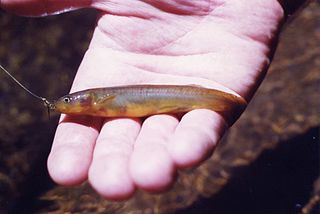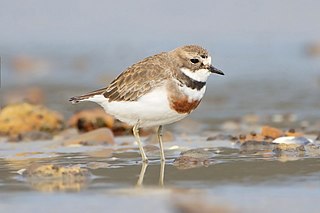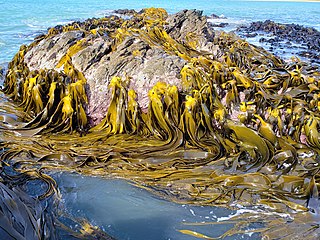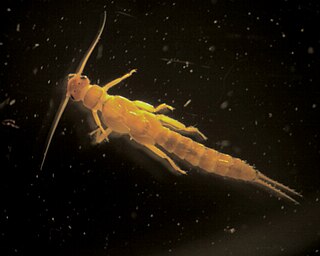
Plecoptera is an order of insects, commonly known as stoneflies. Some 3,500 species are described worldwide, with new species still being discovered. Stoneflies are found worldwide, except Antarctica. Stoneflies are believed to be one of the most primitive groups of Neoptera, with close relatives identified from the Carboniferous and Lower Permian geological periods, while true stoneflies are known from fossils only a bit younger. Their modern diversity, however, apparently is of Mesozoic origin.

Hector's beaked whale, is a small mesoplodont living in the Southern Hemisphere. This whale is named after Sir James Hector, a founder of the colonial museum in Wellington, New Zealand. The species has rarely been seen in the wild.

Batesian mimicry is a form of mimicry where a harmless species has evolved to imitate the warning signals of a harmful species directed at a predator of them both. It is named after the English naturalist Henry Walter Bates, who worked on butterflies in the rainforests of Brazil.

The Galaxiidae are a family of mostly small freshwater fish in the Southern Hemisphere. The majority live in Southern Australia or New Zealand, but some are found in South Africa, southern South America, Lord Howe Island, New Caledonia, and the Falkland Islands. One galaxiid species, the common galaxias, is probably the most widely naturally distributed freshwater fish in the Southern Hemisphere. They are coolwater species, found in temperate latitudes, with only one species known from subtropical habitats. Many specialise in living in cold, high-altitude upland rivers, streams, and lakes.

The double-banded plover, known as the banded dotterel or pohowera in New Zealand, is a species of bird in the plover family. Two subspecies are recognised: the nominate Charadrius bicinctus bicinctus, which breeds throughout New Zealand, including the Chatham Islands, and Charadrius bicinctus exilis, which breeds in New Zealand's subantarctic Auckland Islands.

Durvillaea is a genus of large brown algae in the monotypic family Durvillaeaceae. All members of the genus are found in the southern hemisphere, including Australia, New Zealand, South America, and various subantarctic islands. Durvillaea, commonly known as southern bull kelps, occur on rocky, wave-exposed shorelines and provide a habitat for numerous intertidal organisms. Many species exhibit a honeycomb-like structure in their fronds that provides buoyancy, which allows individuals detached from substrates to raft alive at sea, permitting dispersal for hundreds of days over thousands of kilometres. Durvillaea species have been used for clothing, tools and as a food source by many indigenous cultures throughout the South Pacific, and they continue to play a prominent role in Chilean cuisine.

The colossal squid is the world’s largest squid species and the world’s largest mollusc. It belongs to the Cranchiidae family, that of the cockatoo squids or glass squids. It is sometimes called the Antarctic cranch squid or giant squid and is believed to be the largest squid species in terms of mass. It is the only recognized member of the genus Mesonychoteuthis and is known from only a small number of specimens. The species is confirmed to reach a mass of at least 495 kilograms (1,091 lb), though the largest specimens—known only from beaks found in sperm whale stomachs—may perhaps weigh as much as 600–700 kilograms (1,300–1,500 lb), making it the largest known invertebrate. Maximum total length has been estimated between 10 metres (33 ft) and 14 metres (46 ft) but the former estimate is more likely. The colossal squid has the largest eyes of any known creature ever to exist, with an estimated diameter of 27–30 cm (11–12 in) to 40 cm (16 in) for the largest collected specimen.

Alexandronectes is a genus of elasmosaurid plesiosaur, a type of long-necked marine reptile, that lived in the oceans of Late Cretaceous New Zealand. It contains one species, A. zealandiensis. Fossils of Alexandronectes were found in the Conway Formation of Canterbury, which can be dated to the Early Maastrichtian stage of the Cretaceous. Fossils of it were found around 1872 near the Waipara River, north of Christchurch, New Zealand.

Chloroperlidae are a family of stoneflies, commonly known as green stoneflies, with more than 200 species and 22 genera. They appear green to yellow in colour, and are popularly used among fisherman as bait for trout fishing. Green stoneflies live in the benthic zone of the cold streams and rivers of five continents and four zoogeographical regions, emerging from the water to live in the riparian zone as adults. They are sensitive to pollutants, making them an indicator species for determining the quality of water bodies. Chloroperlidae are hemimetabolous, having no pupal stage, but instead hatch from eggs as nymphs and mature directly into adults. They are omnivorous, feeding on small organisms and plant particles, and become more carnivorous as they mature. The classification of Chloroperlidae is contested, with some believing that they should be considered as members of different orders, as opposed to the order Plecoptera that they currently belong to.

Lednia is a monotypic genus, containing the single species Lednia tumana —a rare, alpine, aquatic insect that is endangered due to likely loss of glaciers and snowpacks in the Glacier National Park and other habitat in the Rocky Mountains due to climate change. The differentiation from the other Nemourids is to look at the abdominal stremite which only the Lednia and paranemoura lack the vesicles of the 9th abdominal stermite.

Dinocras ferreri is a species of stonefly belonging to the family Perlidae.

Eustheniidae is a family of insects in the order Plecoptera, the stoneflies. They are native to Australia, New Zealand, and Chile.

Vegaviidae is an extinct family of birds of uncertain phylogenetic placement, which existed during the Late Cretaceous and possibly the Paleocene. Definitive fossils attributed to the family have only been found in Antarctica, though other fossils from the Southern Hemisphere including Chile and New Zealand may represent this group. The putative Campanian vegaviid from Canada known as Maaqwi, more likely belongs to the Procellariformes.

Austroperlidae is a family of stoneflies in the order Plecoptera. There are about 10 genera and 15 described species in Austroperlidae across southern land masses Australia, New Zealand, and South America.Austroperlidae species are unique among stoneflies in having aposematic (warning) colouration. For instance, the New Zealand black stonefly Austroperla is a forest dwelling shredder that is toxic to predators due to its production of hydrogen cyanide. The warning colouration of this species is mimicked by several lineages of the unrelated non-toxic New Zealand stonefly Zelandoperla.

Zelandoperla maungatuaensis, commonly known as the Maungatua stonefly, is a species of flightless stonefly so far known only from a single mountainside in Otago, New Zealand.

Xanthoperla apicalis is a species of stoneflies in the family Chloroperlidae.

Stenoperla prasina is a species of stonefly belonging to the family Eustheniidae. This species is endemic to New Zealand and is classified as "Not Threatened" under the New Zealand Threat Classification System. It is found on the North, South and Stewart Island / Rakiura Islands as well as on Little Barrier Island. Although adults of this species are most often coloured bright green, this species can be coloured yellow. This species inhabits clean, cold, running streams and rivers with stony bottoms within native bush. It is a known indicator of water quality. The larvae eat plant detritus and other aquatic insects while the adult insects feed on sooty mould fungi as well as other plant matter. The adults of this species are a known food source for New Zealand long tailed bats. Adults have been dissected and have been found to have been carrying Nematomorpha and trematode parasites. The New Zealand Department of Conservation classifies this species as "Not Threatened". In 2022 a specimen of this species was the 5 millionth specimen to be digitised in the Natural History Museum, London collection.
Zelandoperla is a genus of ‘long-tailed’ stoneflies endemic to New Zealand, placed within Southern Hemisphere family Gripopterygidae.

Zelandoperla fenestrata is a widespread endemic New Zealand ‘long-tailed’ stonefly that is often abundant in high-gradient stony streams, from near sea-level up to alpine elevations. The species name 'fenestrata' refers to the window-like rectangular patterning visible on the wings of non-melanic adult specimens.
Aucklandobius turbotti is a species of stonefly in the family Gripopterygidae. The species was first described by Joachim Illies in 1963, and is endemic to the Auckland Islands of New Zealand.


















